Part of a series of articles titled Alaska Park Science - Volume 17, Issue 1. Migration: On the Move in Alaska.
Article
A Survey of Human Migration in Alaska's National Parks through Time
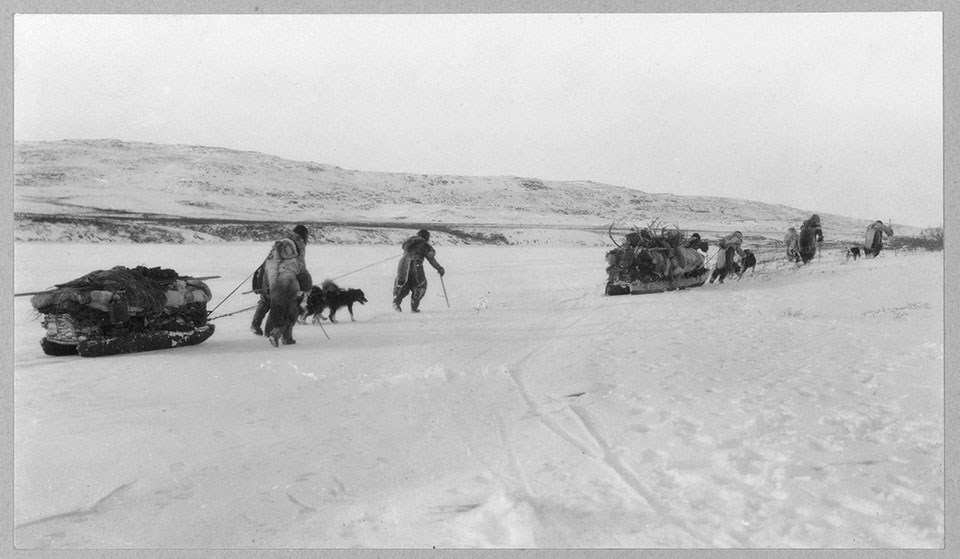
Frank and Frances Carpenter collection, Library of Congress
To tell the story of human migration in Alaska’s national parklands, we must consider the archaeological record of the entire state and the neighboring regions in Canada and Russia. Archaeologists have come to learn that the first Alaskans did not just arrive 14,000 years ago and stay in one place, but rather, people have been coming and going, adapting and mixing with each other ever since humans first arrived to Beringia (Potter 2010). In fact, current research demonstrates that native Alaskan populations in prehistory show signs of growth and decline, regional abandonment, and recolonization of depopulated areas (Mullen 2012, Potter 2008, Tremayne and Brown 2017). Some regions of Alaska show population and cultural stability over vast time-periods, while others indicate rapid and frequent change (Tremayne and Winterhalder 2017). Using observable changes in artifact types, styles, and designs, archaeologists have constructed a detailed culture history for Alaska (Figure 1). However, many questions about the origins and relatedness of the people that created these materials remain unanswered.
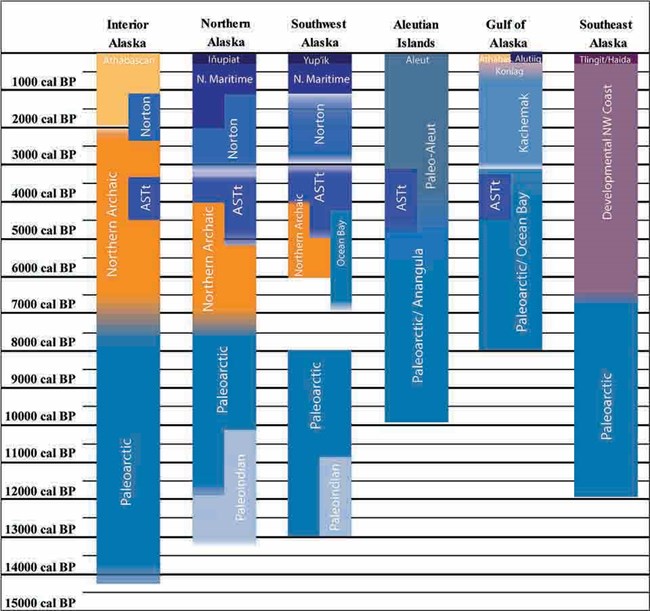
One method to differentiate between migration and in-place change is to use many lines of evidence, including the archaeological record (e.g., artifact types and styles, radiocarbon dates), biological data (e.g., skeletal morphology, dental records, genetics), and linguistic relationships. Each line of evidence is fraught with complications, but also the only source of information we have to work with. With archaeological data, we can only trace the distribution of a cultural tradition and, in ideal cases, track its spread into a particular region at a given point in time. Without associated biological remains, we cannot be certain that it was population replacement and not cultural diffusion (sharing of ideas and technologies). Historical linguistics can also provide compelling clues towards cultural and biological affinities, but we must exercise caution when assigning prehistoric cultures and genetic lineages to a linguistic family, as researchers have long known that languages can spread and evolve independently. Additionally, the further back in time we go, the less confidence linguists have in language reconstruction. As such, archaeologists typically use linguistics relationships as a complementary line of evidence when searching for historical relationships. With that said, it is fair to assume that it is more likely than not that genetic populations, their associated material cultures, and languages correlate with each other (Potter 2010). Taken together, material culture, skeletal remains, genetics, and linguistics can help archaeologists trace the movement and spread of particular prehistoric populations. Based on this data, the following provides a short summary of the current hypotheses for major human migrations and culture change in Alaska prehistory.
The First Migration into Alaska and the Americas (and Back Again)
Archaeologists interested in the peopling of the Americas have long looked to Alaska for evidence of the colonizing population. During the Last Glacial Maximum (LGM) 24,000-15,000 years ago, glaciers locked up so much water on land that sea levels were at least 120 meters lower than today exposing a land bridge between Alaska and Asia. Researchers refer to this area as Beringia (Figure 2). The glaciers at this time were so large that they effectively cut off Alaska from the rest of North America, making it geographically and ecologically part of northeast Asia. There is broad consensus in the scientific community that humans spread into Beringia during the LGM and dispersed into the Americas from there (Hoffecker et al. 2016, Potter et al. 2017). However, significant debate persists about the timing and route of the colonizers moving south from Alaska (e.g., Braje et al. 2017, Potter et al. 2018).
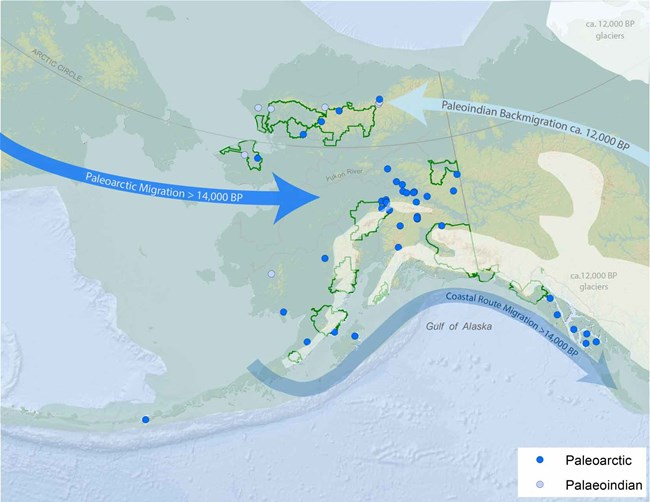
The arrows indicate the directionality of the proposed first migration to Alaska across Beringia and the back migration of Paleoindians through the ice-free corridor around 12,000-13,000 years ago. Glacial extent estimated from Potter et al. (2017).
The traditional interpretation, known as the Clovis-First model, was that the first Americans passed through Alaska and migrated south through an ice-free corridor into mid-latitude North America (Meltzer 2009). Others contend that there were people south of the great ice sheets many thousands of years before Clovis (Dillehay 1997) and that the ice-free corridor would not have been open early enough for people to pass through that route (Pedersen et al. 2016). Proponents of the coastal migration hypothesis argue the first Americans must have taken a coastal route from Alaska south at time prior to the opening of the ice-free corridor (e.g., Braje et al. 2017; Figure 2). The source population then would have been a maritime-adapted group that lived on the shores of Beringia. Evidence for these coastal migrants, of course, would now be under water. Still, many archaeologists question this hypothesis based on the lack of hard evidence and alternate interpretations for the “pre-Clovis” sites in the Americas hang on the timing for the opening of the ice-free corridor (Potter et al. 2018). A single discovery of pre-Clovis site on the coast or within the interior would be very significant.
While these archaeological debates continue, the field of ancient population genetics has begun to make significant contribution toward our understanding of prehistoric relationships between North America and greater Beringia. Proponents of what is termed the Beringian Standstill hypothesis found that populations in Alaska and the rest of North America were all descended from a northeast Asian or Beringian population that was genetically separated/isolated from their Asian ancestors for thousands of years before colonizing the Americas (Hoffecker et al. 2014, Tamm et al. 2007). To date, investigators have yet to discover conclusive archaeological evidence of this hypothetical population. However, recent work by University of Alaska, Fairbanks archaeologist Ben Potter and colleagues discovered that the DNA of 11,000 year old humans from the Upward Sun River site shows the first Alaskans are genetically distinct from all other Native American populations, confirming the existence of a “Beringian” population (Moreno-Mayar et al. 2018).
While the earliest sites of the Beringian Standstill population remains undiscovered, our knowledge of the first archaeological culture in Alaska is increasing with each new field season. So far, the oldest undisputed site in Alaska, Swan Point located in the Tanana Valley, dates to around 14,000 years old (Potter et al. 2017). Archaeologists refer to the material remains of the oldest archaeological sites in Alaska as the Paleoarctic tradition (see Figure 1). Researchers define the Paleoarctic tradition by the presence of microblade technology and unique bifacially worked stone tools, as exemplified by sites such as found at Onion Portage in Kobuk Valley National Park (Anderson 1988). However, by about 12,000–8,000 years ago, some of these people began exploiting resources in coastal contexts developing a tradition sometimes referred to as Paleomarine (Davis 1990, Potter 2010). Interestingly, the Alaskan Paleoarctic does not resemble Paleoindian or Clovis material culture from mid-continent North America; instead, it shares closest resemblances to the Diuktai Culture of Asia, demonstrating a migration west to east across Beringia (Potter 2010; Figure 2), as archaeologists have long suggested.
To complicate the picture, researchers have also discovered evidence for Paleoindians at multiple sites in Alaska (including in both Bering Land Bridge and Noatak national preserves), that contain both fluted and tapering-base spear points similar to those of mid-continental North America (Goebel et al. 2013, Rasic 2011). What is notable about these discoveries is that all of the fluted point sites post-date Clovis by 1,000 years or so, prompting some researchers to propose a “back-migration” into Alaska from Paleoindian populations from the south (Goebel et al. 2013; Figure 2). If the fluting technique originated in Alaska, we would expect to find the oldest “Clovis” sites here. To date we do not, but this does not mean their origins are not ultimately from Beringia, especially considering some of the tapering-base lanceolate points such seen in Sluiceway Complex at sites in the Noatak National Preserve have radiocarbon dates contemporaneous with Clovis (Rasic 2011). More work is needed to sort out these ancient relationships, but a story of the first migrations in Alaska is beginning to emerge.
Based on these competing models, the expect-ations are that two biologically and culturally distinct populations came to inhabit Alaska by the close of the Pleistocene 11,000 years ago: the Paleoarctic culture and the Paleoindian culture. While we lack genetic data from Paleoindians in Alaska, mitochondrial DNA (mtDNA) from two Paleoarctic sites predating 10,000 years ago (Lindo et al. 2017, Tackney et al. 2015) provides compelling evidence in support of the Beringian Standstill hypothesis, but also that the genetic diversity of the Pleistocene population within Alaska is complex and varied. For example, the DNA sequences of two infants from 11,500-year-old burials at Upward Sun River revealed mtDNA haplogroups B2 and C1b, which are rare in modern populations from northern North America, but are found today primarily in Native American populations in the mid-latitude North and South America (Tackney et al. 2015) suggesting ancient biological affinities. At On Your Knees Cave site, from the southeast Alaska Island of Prince of Wales, the 10,300-year-old Shuká Káa man revealed mtDNA D4h3a, which is the same as Anzick-1, a Clovis skeleton from Montana (Lindo et al. 2017). An analysis of the complete genome of Shuká Káa man along with other DNA samples from the region shows genetic continuity through to modern populations of the Northwest Coast region, while the Clovis individual shares greater affinities to Native Americans in Central and South America. Even more recently, Moreno-Mayar et al. (2018) sequenced the nuclear genome of the 11,000-year-old Upward Sun River babies, demonstrating the people who possessed a Paleoarctic culture have a distinct, but related, genome from all other Native Americans. In fact, the current study shows that the oldest genome in Alaska is a unique, newly discovered genetic group that existed during the late Pleistocene/early Holocene, but has no living descendants today in the Americas. This discovery suggests a genetic split between Paleoarctic and Paleoindian people happened while Beringia was still dry land. The implications of these findings on the migration(s) into the Americas is that the hypothetical source population from Beringia was more genetically diverse than once thought, and that Paleoarctic and Paleoindian archaeological cultures represent related, but distinct biological populations.
The Spread of the Northern Archaic and the Origins of Athabaskans
As the early Holocene conditions continued to warm and rising waters inundated the Bering Land Bridge, Paleoarctic people persisted in Alaska by diversifying and adapting to regionally specific ecological niches and maritime habitats. However, archaeologists recognize the appearance of a new culture in Alaska around 6,500-7,000 years ago, demarcated by a suite of new artifact types, in particular the notched dart point, referred to as the Northern Archaic tradition (Anderson 1968, Esdale 2008). Archaeologists have documented Northern Archaic sites across Alaska and they are common in most of Alaska’s national parklands (Figure 3). Some representative Northern Archaic sites include Palisades in Cape Krusenstern National Monument (Giddings and Anderson 1986), Onion Portage in Kobuk Valley National Park (Anderson 1988), and Agiak Lake in Gates of the Arctic National Park and Preserve (Wilson and Slobodina 2007). It is still unknown if the origin of this new tradition represents the spread of ideas and new technologies into the Paleoarctic populations or if it represents the physical immigration of a new group of people that displaced their indigenous contemporaries. Based on persistent use of some artifact types, namely microblade technology, Potter (2010) argued for continuity between the Paleoarctic tradition people and the Northern Archaic with minor diffusion of ideas from Canada and mid-latitude North America. However, the genetic study of the Upward Sun River burials (Moreno-Mayar et al. 2018), indicates an influx of new genes into Alaska must have occurred at some point following the existence of the Paleoarctic tradition. Perhaps the Northern Archaic people brought in the new genes. The question remains: where did this new group of people come from?
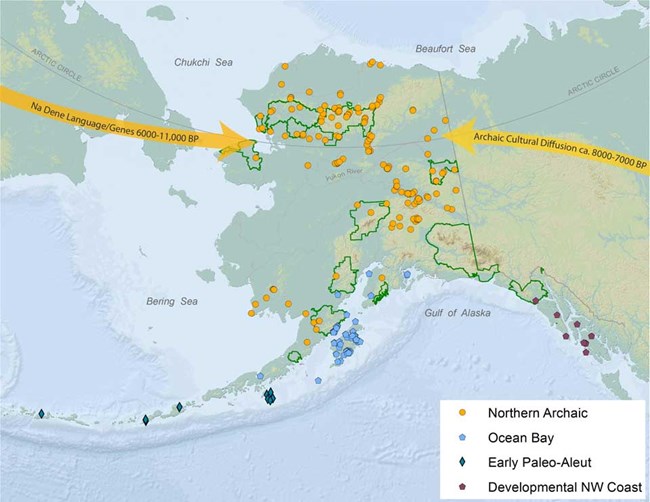
The arrows indicate hypothetical movement of ideas or language into the existing biological population, which we assume to be ancestors of the Northern Archaic tradition and coastal Paleomarine cultures. National parklands are outlined in green.
Many researchers consider the Northern Archaic people to be direct ancestors of Na Dene speaking Athabaskans (e.g., Esdale 2008, Potter 2008). Interestingly, historical linguistic analysis suggests the origins of the Na Dene language family is in central Asia (Kari and Potter 2010). This would indicate, as others have argued before (e.g., Greenberg et al. 1986), that a second migration wave from Asia occurred many thousands of years after the arrival of the first Beringians. Others have pointed out the notched point technology originated first in the mid-latitudes of North America (Anderson 1968, Esdale 2008), proving the Northern Archaic technology arrived from the east, not Asia. Ancient DNA from a Northern Archaic individual could help answer these questions, but to date archaeologists have yet to discover human remains from these sites, so we have no genetic data available to test these competing hypotheses. However, recognizing that the Athabaskan DNA does not match the Paleoarctic genetic signatures, we can assume there was an influx of genes that occurred with the arrival of Northern Archaic people. When and where they came from remain important questions for archaeologists to work out. Since there are so many Northern Archaic sites on NPS managed lands, our program can play an important role in helping solve this mystery.
The Arctic Small Tool Tradition Migration
While the Northern Archaic people were dominating the Alaska interior 5,000 years ago, and coastal Paleoarctic descendants continued to thrive in southern Alaska, another group of people located in eastern Siberia was poised to embark on a new migration that would ultimately result in the colonization of the entire North American Arctic from Alaska to Greenland. The Arctic Small Tool tradition (ASTt), as defined by William Irving (1957), represents a stone tool technology employed by a hunter-gatherer culture that originated during the Siberian Neolithic sometime before 6,000-7,000 years ago (Mochanov and Powers 1969). Archaeologists have discovered dozens of ASTt sites in Alaska national parklands and these sites are particularly common in our northern parks (Figure 4). Most of the information we have about the ASTt comes from their ancient camps found at Cape Krusenstern National Monument (Giddings and Anderson 1986), Bering Land Bridge National Preserve (Tremayne 2015), Onion Portage in Kobuk Valley National Park, and at numerous lakeside sites in the Brooks Range best exemplified by the Matcharak Lake site in Gates of the Arctic National Park (Tremayne 2011). National Park Service archaeologists working at Kuzitrin Lake in Bering Land Bridge National Preserve discovered an ASTt site with the oldest dates ever reported at 5450±320 (Harritt 1998). In Southwest Alaska, Don Dumond (2005) defined the southern ASTt at Brooks Camp in Katmai National Park and Preserve, and recently traces of this group were documented in Lake Clark National Park and Preserve, as well (Rogers et al 2013). The fact that so many of our national parks in Alaska have ASTt sites, including possibly the oldest ever found, demonstrates the importance of our mission in telling this story.
Based on stone tool forms the ancestors of the ASTt people appear to be descendants of Siberian Paleoarctic cultures (Mochanov and Powers 1969). Archaeologists assume that the ASTt people crossed the Bering Strait around 5,000 years ago, presumably by boat, spreading first along the coastal areas of Alaska, south to Bristol Bay and Cook Inlet, and northeast to the Chukchi Sea, into Canada, and eventually to Greenland (Figure 4; Tremayne and Winterhalder 2017). Over the next two millennia, the ASTt population grew rapidly, moving into both coastal and tundra ecoregions of Arctic and western Alaska, displacing the Northern Archaic groups that once occupied these territories. Currently, there is very little archaeological evidence for mixing between ASTt and Northern Archaic populations; their archaeology sites are very distinct and distin-guishable from each other. Where they overlap geographically, the ASTt is always younger than the Northern Archaic occupations, providing the evidence for population replacement rather than gene flow and cultural transmission. In southwest Alaska on the other hand, particularly the Aleutians and Kodiak, there is strong evidence for the transmission of culture, and probably genes, between ASTt people and the Paleoaleut of the Aleutian Islands (Davis and Knecht 2010, Gilbert et al. 2008) and Ocean Bay people living in Kodiak (Steffian and Saltonstall 2005; Figure 4).
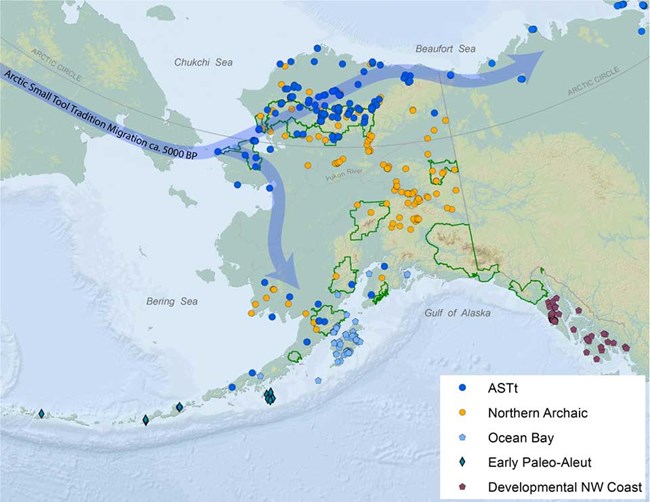
The arrows indicate the proposed directionality of the ASTt migration into Alaska and across the Arctic. National parklands are outlined in green.
The discoverers of the ASTt, referred to the makers as Paleoeskimos, which implied there was a direct relationship to modern Eskimo people, today referred to by their chosen names Iñupiat, Yup’ik, and Inuit people. While there is limited archaeological evidence of cultural continuity from Paleoeskimo to Neoeskimos (discussed below), the biological relationship is less certain. Currently, we lack genetic data from ASTt people in Alaska, but researchers published the results of a fully sequenced genome from a 4,000-year-old Saqqaq ASTt man from Greenland (Rasmussen et al. 2010). Remarkably, this ancient ASTt DNA sequence showed that the closest living populations to this individual were not Inuit from Greenland or Canada, but people from Chukotka, Russia and the Aleutian Islands (Gilbert et al. 2008, Rasmussen et al. 2010). A subsequent analysis of 169 mitochondrial ancient DNA sequences from prehistoric Arctic populations clearly demonstrated that ASTt people and their descendants are distinct from modern Inuit and Iñupiat. In fact, it looks increasingly like another migration event from Alaska to Greenland 1,000 years ago led to the extinction of the ASTt descendants, known as Dorset, in the east (Raghavan et al. 2014). The fate of ASTt people in Alaska, however, remains a mystery. Archaeologists generally agree that the people of the ASTt reconfigured their economy to adapt to new conditions as climate changed. A new emphasis on coastal resources and marine mammal hunting resulted in the development of the Norton culture from the late ASTt people. The Norton culture dominated coastal Alaska from around 2,800-2,000 years ago in northwest Alaska and to 1,000 years ago in southwest Alaska. By 1000 A.D., this long-lived tradition disappeared from the record. What happened?
The Great Thule Migration
Beginning around 2,000 years ago, another new culture appears in the Bering Strait region that was in direct competition with the Late ASTt/Norton people discussed above. Archaeologists refer to this culture as the Northern Maritime tradition (Collins 1964). Researchers recognize the Northern Maritime tradition by their extensive use of ivory, elaborate artistic engravings on hunting equipment and ritualistic objects, and their near-total reliance on marine resources for subsistence. We find the oldest Northern Maritime sites on St. Lawrence Island in the Bering Sea region, and evidence of connections with Chukotka are well established. The question remains, were the people of the Northern Maritime tradition directly descended from the ASTt and Norton people or were they instead part of another newly arrived biological population from Asia that we have yet to identify?
There remains many questions about the origins of Northern Maritime tradition, but what is clear is that by 1000 AD they morphed into a group that is widely referred to as the Thule tradition, often called Neoeskimos in the literature. Archaeologists and geneticists agree the Thule people are the direct ancestors of Inuit, Iñupiat, and Yup’ik people (Raghavan et al. 2014). Importantly, the Thule are genetically distinct from ASTt people demonstrating once again the arrival of a new biological population. Once the Thule culture reached maturity, this group rapidly spread across the Arctic, from northwest Alaska, south to Bristol Bay and northeast to Greenland, culturally and biologically replacing and/or assimilating all of the late ASTt people they encountered (Figure 5). In the eastern Arctic, the replacement appears to be complete. In Alaska, there are indications that ASTt genes have survived into the modern populations, however in very low frequencies (Raff et al. 2015). By 800-700 A.D., the Thule tradition became so dominant that it also overtook the indigenous populations on Kodiak Island and along the coast of the Gulf of Alaska, where previously populations that probably retained some of the genes from Paleoarctic people still existed. Some of the most important Thule sites that have been studied are found in Alaska’s national parks, including on the beach ridges of Cape Krusenstern National Monument (Giddings and Anderson 1986) and Cape Espenberg in Bering Land Bridge National Preserve (Alix et al. 2017). Today we find Thule sites everywhere that Iñupiat and Yup’ik people live, suggesting cultural continuity for at least 1,000 years.
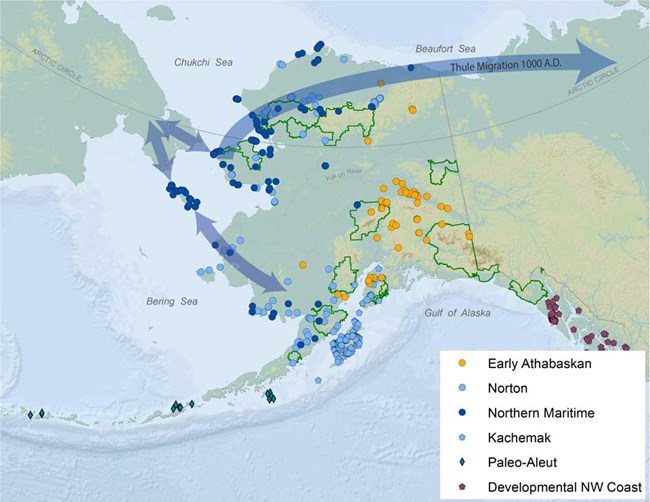
Arrows indicate the proposed directionality of the Thule migration, which began around 1000 A.D. National parklands are outlined in green.
Interestingly, the Thule never penetrated far into the interior of Alaska, presumably because the Athabaskan people continued to control these territories. The result of this last great migration resulted in the cultural and linguistic boundaries of Alaska Native populations that Russian, European and American explorers first documented beginning in the 18th century. Hundreds, maybe even thousands, of Thule and late prehistoric sites are found in Alaska’s national parklands. Our goal is to continue to study and protect these sites so that we can better understand their biological and cultural origins and to share the story of survival and adaptation in Alaska.
Summary
In this article, I have discussed a multitude of evidence for at least four major migrations to and from Alaska since the arrival of the first people over 14,000 years ago. The pace at which we are acquiring new information about prehistoric genetic variability, biological relationships, migrations, and population dynamics is accelerating. We still have a great deal to learn and new questions emerge with each new study. Alaska’s national parklands contain many of the key sites that have defined the traditions and archaeological cultures discussed and the National Park Service is mandated to preserve the sites that tell these stories. The efforts of National Park Service archaeologists, other staff, and outside researchers are integral to fulfilling our mission to protect and interpret archaeological resources on our public lands. Ultimately, the discoveries made by National Park Service archaeologists transcend the park boundaries and are relevant for understanding the prehistory of all of Alaska, for the first people that roamed these lands knew nothing of the boundaries modern people would impose upon the land. The first Alaskans and their descendants went where they needed and left traces of the migrations across the entire state. It is our mission to discover, manage, and protect the sites that preserve this record and to share these stories for the benefit of all.
REFERENCES
Alaska Heritage Resource Survey. 2017.
https://dnr.alaska.gov/ohasecurity/portal.
Alix, C., O. K. Mason, L. Norman, N. Bigelow, C. Maio, S. Anderson, S. Griece-Rawson, A. Lincoln, D. O’Rourke, L. Poupo and M. Vanlandeghem. 2017.
Birnirk Prehistory and the Emergence of the Inupiaq Culture in Northwestern Alaska; Achaeological and Anthropological Perspectives. Field Investigations at Cape Espenberg 2016. Annual Report to the National Park Service, Department of the Interior.
Anderson, D. D. 1988.
Onion Portage: The Archaeology of a Stratified Site from the Kobuk River, Northwest Alaska. Anthropological Papers of the University of Alaska 22(1-2).
Anderson, D. D. 1968.
A Stonage Campsite at the Gateway to America. Scientific American 218(6):24-33.
Braje, T. J., T. D. Dillehay, J. M. Erlandson, R. G. Klein and T. C. Rick. 2017.
Finding the first Americans. Science 358(6363):592-594.
Burch, E. S., Jr. 2006.
Social Life in Northwest Alaska. Fairbanks: University of Alaska Press.
Collins, H. B. 1964.
The Arctic and Subarctic. In: Jennings, J. D. and Norbeck, E., editors. Prehistoric Man in the New World. Chicago: University of Chicago Press. p 85-116.
Davis, R. S. and R. A. Knecht. 2010.
Continuity and Change in the Eastern Aleutian Archaeological Sequence. Human Biology 82(5-6):507-524.
Davis, S. D. 1990.
Prehistory of Southeastern Alaska. In Handbook of North American Indians, Volume 7: Northwest Coast, edited by W. Suttles, pp. 197-202. Smithsonian Insituton, Washington.
Dillehay, T. D. 1997. Monte Verde: a Late Pleistocene settlement in Southern Chile: Washington D.C.: Smithsonian Series in Archaeological Inquiry.
Dumond, D. E. 2005.
The Arctic Small Tool Tradition in Southern Alaska. Alaska Journal of Anthropology 3(2):67-79.
Esdale, J. A. 2008.
A current synthesis of the northern archaic. Arctic Anthropology 45(2):3-38.
Giddings, J. L. and D. D. Anderson. 1986.
Beach Ridge Archaeology of Cape Krusenstern: Eskimo and Pre-Eskimo Settlements around Kotzebue Sound, Alaska. Publications in Archeology 20. National Park Service, U.S. Department of the Interior, Washington D.C.
Gilbert, M. T. P., T. Kivisild, B. Grønnow, P. K. Andersen, E. Metspalu, M. Reidla, E. Tamm, E. Axelsson, A. Götherström, P. F. Campos, M. Rasmussen, M. Metspalu, T. F. G. Higham, J. Schwenninger, R. Nathan, C. De Hoog, A. Koch, L. Nukaaraq Møller, C. Andreasen, M. Meldgaard, R. Villems, C. Bendixen and E. Willerslev. 2008.
Paleo-Eskimo mtDNA Genome Reveals Matrilineal Discontinuity in Greenland. Science 320(5884):1787-1789.
Goebel, T., H. L. Smith, L. DiPietro, M. R. Waters, B. Hockett, K. E. Graf, R. Gal, S. B. Slobodin, R. J. Speakman, S. G. Driese, D. Rhode. 2013.
Serpentine Hot Springs, Alaska: results of excavations and implications for the age and significance of northern fluted points. Journal of Archaeological Science 40(12):4222-4233.
Greenberg, J. H., C. G. Turner, S. L. Zegura, L. Campbell, J. A. Fox, W. S. Laughlin, E. J. E. Szathmary, K. M. Weiss and E. Woolford. 1986.
The Settlement of the Americas: A Comparison of the Linguistic, Dental, and Genetic Evidence [and Comments and Reply]. Current Anthropology 27(5):477-497.
Harritt, R. K. 1998.
Paleo-Eskimo Beginnings in North America: A New Discovery at Kuzitrin Lake, Alaska. Etudes/Inuit/Studies 22(1):59-81.
Hoffecker, J. F., S. A. Elias, D. H. O’Rourke, G. R. Scott, and N. H. Bigelow. 2016.
Beringia and the global dispersal of modern humans. Evolutionary Anthropology: Issues, News, and Reviews 25(2):64-78.
Hoffecker, J. F., S. A. Elias, and D. H. O’Rourke. 2014.
Out of Beringia? Science 343(6174):979-980.
Irving, W. N. 1957.
An archaeological survey of the Susitna Valley. Anthropological Papers of the University of Alaska 6:37-51.
Kari, J. and B. A. Potter. 2010.
The Dene-Yeniseian Connection: Bridging Asia and North America. Anthropological Papers of the University of Alaska, New Series 5(1-2):1-24.
Lindo, J., A. Achilli, U. A. Perego, D. Archer, C. Valdiosera, B. Petzelt, J. Mitchell, R. Worl, E. J. Dixon, T.E. Fifield, T.E. Fifield, M. Rasmussen, E. Willerslev, J.S. Cybulski, B.M. Kemp, M. DeGiorgio, and R.S. Malhi. 2017.
Ancient individuals from the North American Northwest Coast reveal 10,000 years of regional genetic continuity. Proceedings of the National Academy of Sciences 114(16):4093-4098.
Meltzer, D. J. 2009.
First Peoples in a New World. Berkeley, California: University of California Press.
Mochanov I. A. and W. R. Powers. 1969.
The Bel’Kachinsk Neolithic Culture on the Aldan. Arctic Anthropology 6(1):103-120.
Moreno-Mayar, J. V., B. A. Potter, L. Vinner, M. Steinrücken, S. Rasmussen, J. Terhorst, J. A. Kamm, A. Albrechtsen, A. Malaspinas, M. Sikora, J. D. Reuther, J. D. Irish, R. S. Malhi, L. Orlando, Y. S. Song, R. Nielsen, D. J. Meltzer and E. Willerslev. 2018.
Terminal Pleistocene Alaskan genome reveals first founding population of Native Americans. Nature 553:203.
Mullen, P. O. 2012.
An Archaeological Test of the Effects of the White River Ash Eruptions. Arctic Anthropology 49(1):35-44.
Pedersen, M. W., A. Ruter, C. Schweger, H. Friebe, R. A. Staff, K. K. Kjeldsen, M. L. Z. Mendoza, A. B. Beaudoin, C. Zutter, N. K. Larsen, B. A. Potter, R. Nielsen, R. A. Rainville, L. Orlando, D. J. Meltzer, K. H. Kjær, and E. Willerslev. 2016.
Postglacial viability and colonization in North America’s ice-free corridor. Nature 537(7618):45-49.
Potter, B. A. 2010.
Archaeological Patterning in Northeast Asia and Northwest North America: An Examination of the Dene-Yeiseian Hypothesis. Anthropological Papers of the University of Alaska, New Series 5(1-2):138-167.
Potter, B. A. 2008.
Radiocarbon Chronology of Central Alaska: Technological Continuity and Economic Change. Radiocarbon 50(2):181-204.
Potter, B. A., A. B. Beaudoin, C. V. Haynes, V. T. Holliday, C. E. Holmes, J. W. Ives, R. Kelly, B. Llamas, R. Malhi, S. Miller, D. Reich, J. D. Reuther, S. Schiffels and T. Surovell. 2018.
Arrival routes of first Americans uncertain. Science 359(6381):1224-1225.
Potter, B. A., J. D. Reuther, V. T. Holliday, C. E. Holmes, D. S. Miller, and N. Schmuck. 2017.
Early colonization of Beringia and Northern North America: Chronology, routes, and adaptive strategies. Quaternary International 444:36-55.
Raff, J. A., M. Rzhetskaya, J. Tackney and M. G. Hayes. 2015.
Mitochondrial diversity of Iñupiat people from the Alaskan North Slope provides evidence for the origins of the Paleo- and Neo-Eskimo peoples. American Journal of Physical Anthropology 157(4):603-614.
Raghavan, M., M. DeGiorgio, A. Albrechtsen, I. Moltke, P. Skoglund, T.S. Korneliussen, B. Grønnow, M. Appelt, H.C. Gulløv, T.M. Friesen, W. Fitzhugh, H. Malmström, S. Rasmussen, J. Olsen, L. Melchior, B. T. Fuller, S. M. Fahrni, T. Stafford, V. Grimes, M. A. Priscilla Renouf, J. Cybulski, N. Lynnerup, M. Mirazon Lahr, K. Britton, R. Knecht, J. Arneborg, M. Metspalu, O. E. Cornejo, A. Malaspinas, Y. Wang, M. Rasmussen, V. Raghavan, T. V. O. Hansen, E. Khusnutdinova, T. Pierre, K. Dneprovsky, C. Andreasen, H. Lange, M. G. Hayes, J. Coltrain, V. A. Spitsyn, A. Götherström, L. Orlando, T. Kivisild, R. Villems, M. H. Crawford, F. C. Nielsen, J. Dissing, J. Heinemeier, M. Meldgaard, C. Bustamante, D. H. O’Rourke, M. Jakobsson, M. T. P. Gilbert, R. Nielsen and E. Willerslev. 2014.
The genetic prehistory of the New World Arctic. Science 345(6200).
Rasic, J. T. 2011.
Functional Variability in the Late Pleistocene Archaeological Record of Eastern Beringia: A Model of Late Pleistocene Land Use and technology from Northwest Alaska. In: Goebel, T. and Buvit, I. editors. From The Yenisei to the Yukon: Interpreting Lithic Assemblage Variability in Late Pleistocene/Early Holocene Beringia. College Station: Texas A&M University Press. p 128-164.
Rasmussen, M., Y. Li, S. Lindgreen, J. S. Pedersen, A. Albrechtsen, I. Moltke, M. Metspalu, E. Metspalu, T. Kivisild, R. Gupta, et al. 2010.
Ancient human genome sequence of an extinct Palaeo-Eskimo. Nature 463(7282):757-762.
Rogers, J. S., D. R. Reger, J. D. Reuther, R. C. Bowman and J. Baxter-McIntosh. 2013.
The Arctic Small Tool Tradition on Cook Inlet: The Magnetic Island Site, Tuxedni Bay, Alaska. Alaska Journal of Anthropology 11(1&2):119-138.
Steffian, A. F. and P. G. Saltonsall. 2005.
Tools but not Toolkits: Traces of the Arctic Small Tool Tradition in the Kodiak Archipelago. Alaska Journal of Anthropology 3(2):17-49.
Tackney, J. C., B. A. Potter, J. Raff, M. Powers, W. S. Watkins, D. Warner, J. D. Reuther, J. D. Irish, D. H. O’Rourke. 2015.
Two contemporaneous mitogenomes from terminal Pleistocene burials in eastern Beringia. Proceedings of the National Academy of Sciences 112(45):13833-13838.
Tamm, E., T. Kivisild, M. Reidla, M. Metspalu, D. G. Smith, C. J. Mulligan, C. M. Bravi, O. Rickards, C. Martinez-Labarga, E. K. Khusnutdinova, S. A. Fedorova, M. V. Golubenko, V. A. Stepanov, M. A. Gubina, S. I. Zhadanov, L. P. Ossipova, L. Damba, M. I. Voevoda, J. E. Dipierri, R. Villems and R. S. Malhi. 2007.
Beringian standstill and spread of Native American founders. PLOS ONE 2(9):e829.
Tremayne, A. H. 2015.
New Evidence for the Timing of Arctic Small Tool Tradition Coastal Settlement in Northwest Alaska. Alaska Journal of Anthropology 13(1):1-18.
Tremayne, A. H. 2011.
An Analysis of Faunal Remains from a Denbigh Flint Complex Camp at Matcharak Lake, Alaska. Arctic Anthropology 48(1):33-53.
Tremayne, A. H. and W. A. Brown. 2017.
Mid-late Holocene population trends, culture change and marine resource intensification in western Alaska. Arctic 70(4):365-380.
Tremayne A. H. and B. Winterhalder. 2017.
Large mammal biomass predicts the changing distribution of hunter-gatherer settlements in mid-late Holocene Alaska. Journal of Anthropological Archaeology 45:81-97.
Wilson, A. K. and N. S. Slobodina. 2007.
Two Northern Archaic Tent Ring Settlements at Agiak Lake, Central Brooks Range, Alaska. Alaska Journal of Anthropology 5(1):43-59.
Last updated: July 20, 2022
